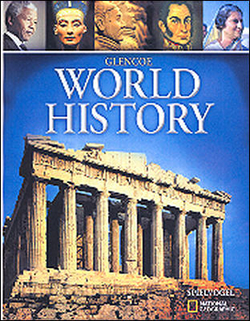Glencoe World History © 2010Chapter 8:
The Asian WorldChapter OverviewsThe years from 400 to 1500 in Asia were marked by periods of invasions and civil wars, interspersed with periods of unification, expanding trade, and economic prosperity. Section 1 China Reunified
China suffered three hundred years of disorder and civil war following the collapse of the Han dynasty in A.D. 200. China was reunified under the Sui dynasty. After a brief period of disorder, the Tang dynasty restored China's power. After the collapse of the Tang, the Song dynasty rose to power. The Song ruled during a period of economic prosperity and cultural achievements.This nearly 700-year period of the three dynasties included major economic and cultural achievements. The introduction of gunpowder, steel manufacturing, and cotton planting spurred economic growth. The economy evolved into a complex mix of agriculture, manufacturing, and trade.In Chinese society the old aristocracy was replaced by a new landed gentry that also supplied candidates for the civil service. However, the status of women remained low. Section 2 The Mongols and China
The Mongol ruler Genghis Khan brought the entire Eurasian land mass under a single rule, creating the largest land empire in history. After Genghis Khan's death, the Mongol Empire was divided into khanates, each under the rule of one of his sons. In 1279 Genghis Khan's grandson Kublai Khan conquered the Song dynasty and established the Yuan, or Mongol, dynasty in China. From the late Song dynasty to the end of the twentieth century, the Chinese government was based on a doctrine called neo-Confucianism. The invention of printing made literature more readily available and poetry flourished. Landscape painting reflected Daoism and Tang artisans perfected the making of porcelain. Section 3 Early Japan and Korea
Ancient Japanese society was made up of clans. The Yamato clan eventually came to dominate and rule Japan. In the early 600s a Yamato prince created a new centralized government based on the Chinese model. Early Japan was a decentralized farming society dominated by aristocratic families. Those who tried to unify Japan were often thwarted by rival noble families. Samurai warriors emerged to serve as guardians of the aristocrats and their property. During one of the more stable interludes, central military rulers called shoguns held power. One of the shoguns defended Japan against the ill-fated Mongol invasion of 1281. Manufacturing and foreign trade—particularly with Korea and China—began in the eleventh century. Women, although subordinate to men, played an active social role, became artists, and were among the most prominent writers. A state religion called Shinto evolved, but Buddhism had a strong following. Early Korean history was marked by civil wars and invasions. The Koryo dynasty emerged in the tenth century and stayed in power after the Mongol invasion in the thirteenth century. After the collapse of the Mongol dynasty in China, the Koryo were overthrown. Section 4 India after the Guptas
After the fall of the Guptas, Buddhism continued to spread abroad, but its influence in India declined. The disunity that followed the collapse of the Gupta Emphire made India vulnerable to Muslim invaders. By 1200 most Indians lived under a Muslim ruling class. From the eleventh through the sixteenth centuries, India faced a series of invaders—first Muslims from the area of modern-day Afghanistan, and later Mongols, Moguls, and Portuguese traders. While most Muslim rulers showed tolerance toward the Hindu majority, Muslims and Hindus had a tense relationship. Most Indians were rural peasant farmers. The landed elites and merchants lived in the cities. Foreign trade flourished even at times of upheaval inside India. Indian culture produced ever more ornate Hindu temples, and use of prose in fiction developed long before it took hold elsewhere. Section 5 Civilization in Southeast Asia
In Southeast Asia, geographical barriers resulted in the survival of many distinct cultures, languages, and religions. These barriers may also explain why the region never united under a single ruler. The economies of Southeast Asia can be divided into two groups: those that were primarily agricultural, and those that were primarily organized around trade. The formation of states, often based on Chinese or Indian models, gave a boost to trade in Southeast Asia. So did the Muslim conquest of northern India. Wealth was concentrated in the cities, which were home to rulers and hereditary aristocrats. Most people were probably subsistence rice farmers. Women in Southeast Asia often had greater rights than their counterparts in China and India. Theravada Buddhism, rejected in India, became the dominant religion in much of Southeast Asia. The exception was the Malay Peninsula, where nearly the entire population converted to Islam.  | 
















